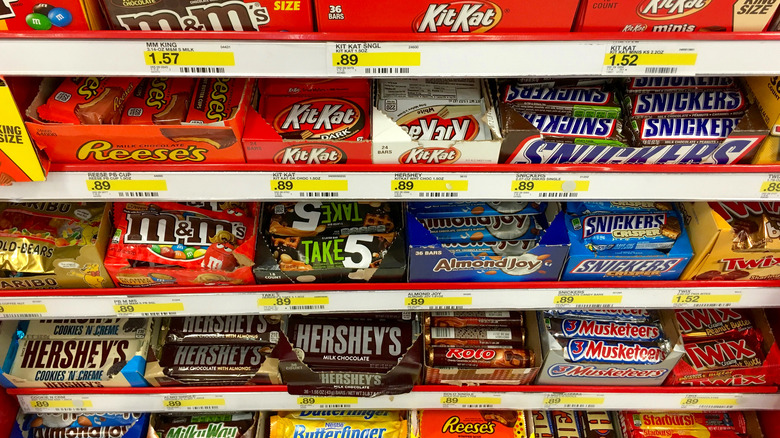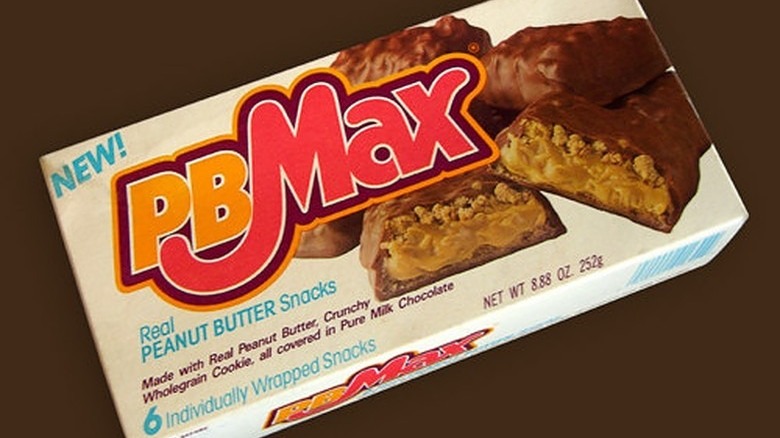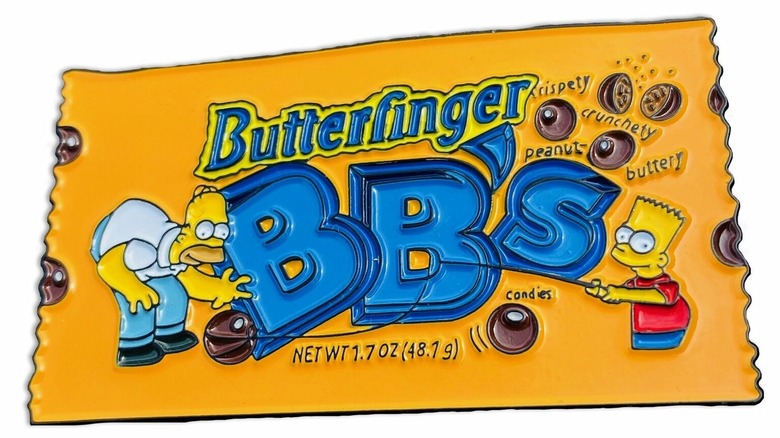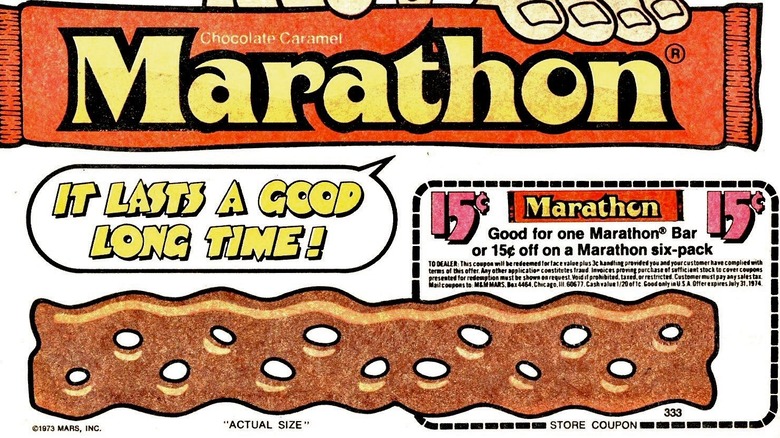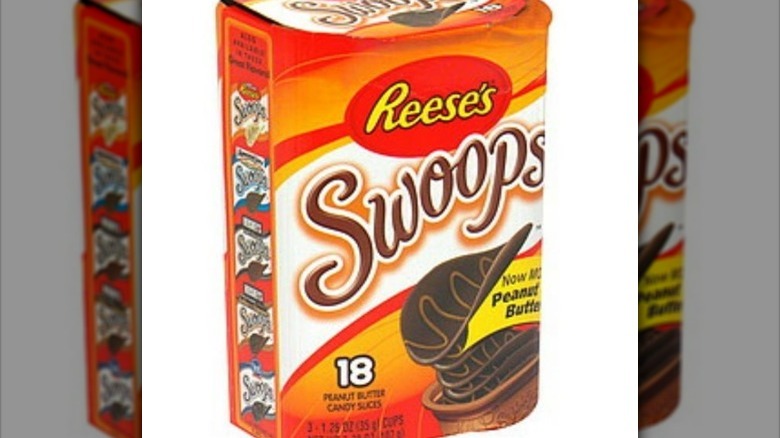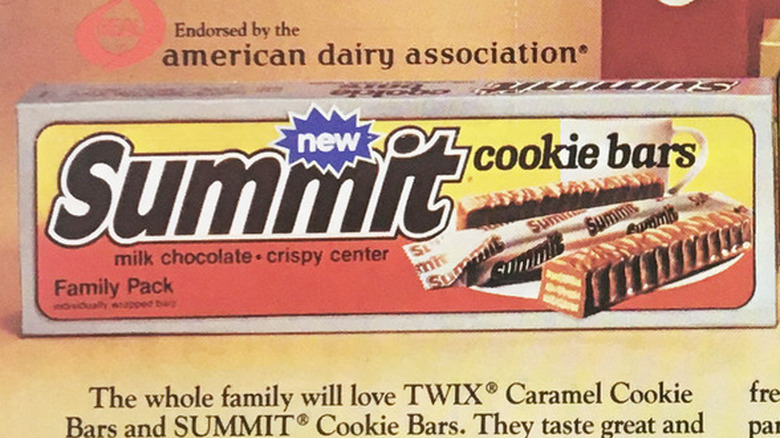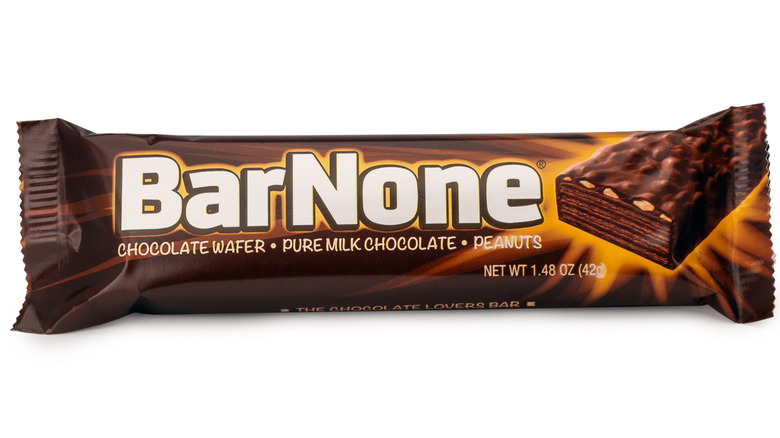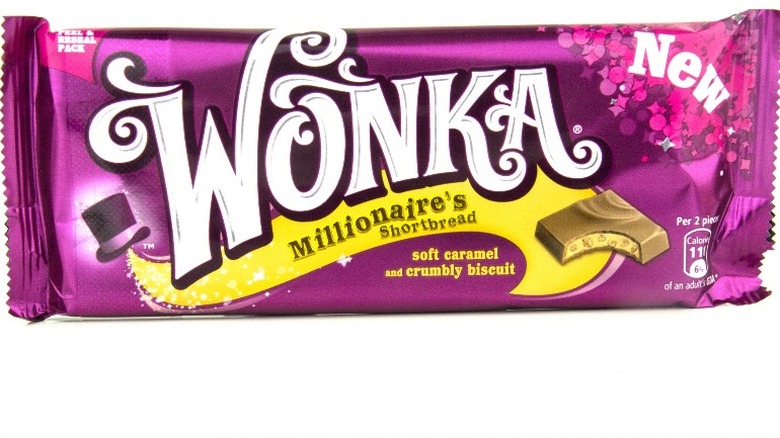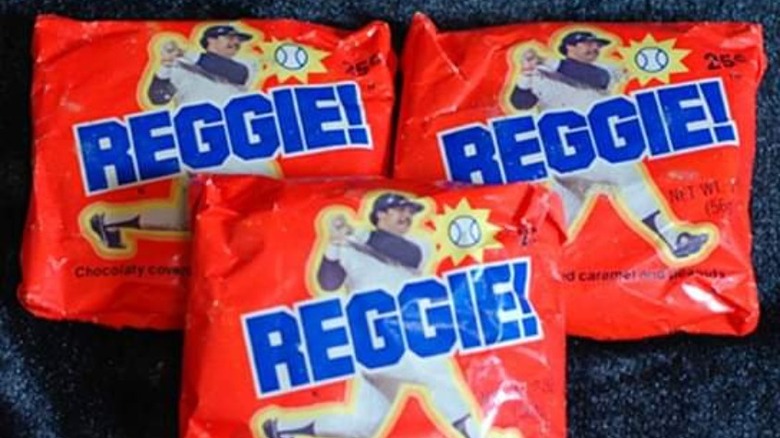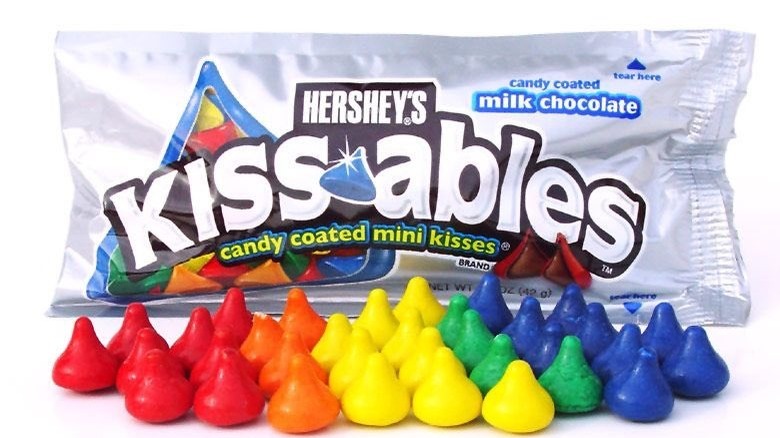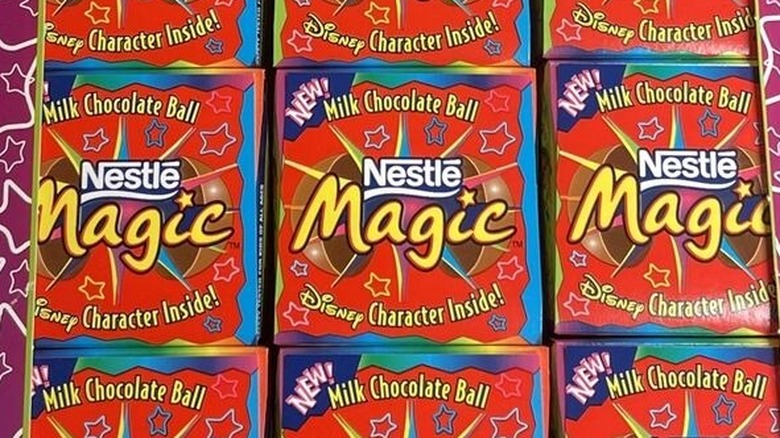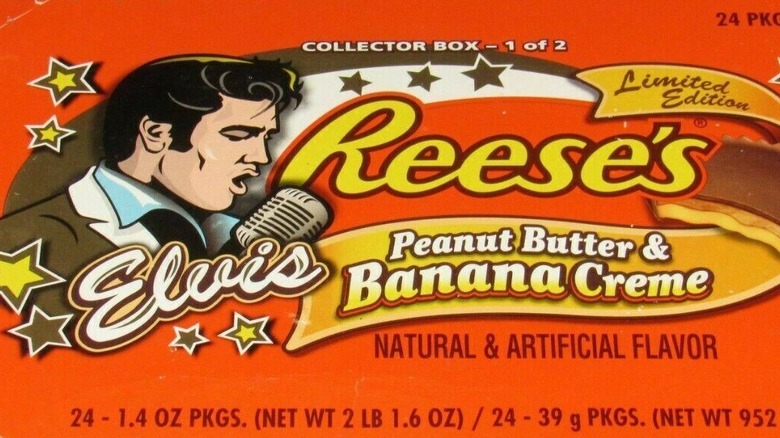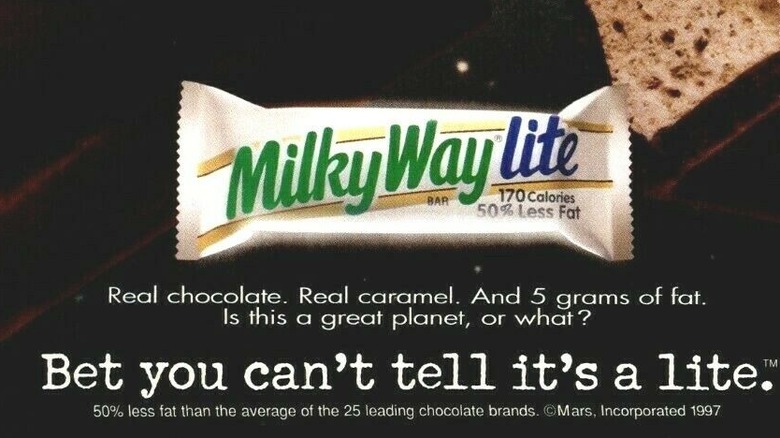The Real Reason These Chocolate Candies Were Discontinued
If nothing is forever, then what makes candy the exception? Well, it's actually not a deviation from the norm since the very nature of human existence dictates all things must end. Philosophy aside, this notion holds true in the world of sweet snacks.
Clearly, despite the near-monolithic presence of candy in this country, there's nothing surprising about the fact that not all chocolates have endured like Snickers or Reese's. In fact, you could fill a graveyard with all of the chocolate candies that have joined the dearly departed over the years — which sounds like a ghoulishly delicious idea for a Halloween-themed advertisement quite frankly.
Whether it's obvious why a product meets its maker or not, many of us harbor a morbid fascination for those food items that have faded from existence. Yet even if it's not entirely clear why a particular chocolate candy has been discontinued, there's usually some evidence to clue us in to the real story. From PB Max to Milky Way Lite, here are the real reasons why some chocolate sweets have been permanently removed from shelves.
PB Max
The rich and famous aren't really like average ordinary folks. Lifestyle aside, folks with more money than you could spend in a lifetime often seem to develop some bizarre quirks. Now, this doesn't mean the super-rich are necessarily swimming in pools of gold coins, but how else can you explain the perplexing fact that the Mars family — billionaire owners of the candy conglomerate and the third wealthiest family in the U.S. as of 2021 (via Forbes) — allegedly killed production of the fairly popular PB Max in the early 1990s simply because they don't like peanut butter?
Ending sales of a product that appeared to make "substantial contributions to the family's coffers" (as described in the book, "Now I Know More") may be hard to fathom for those of us who aren't worth $94 billion. Yet the Mars family's distaste for peanut butter does seem to have ended the company's foray into the peanut butter and chocolate game — leaving Reese's Peanut Butter Cups as the unchallenged king of the mountain.
Butterfinger BB's
If you came here to discover the precise reason why a number of now-extinct chocolate candies met their unfortunate fate, you'll have to be lenient. As much as we'd like to say there's an exact explanation for the demise of Butterfinger BB's, the fact is it's unclear why they were discontinued — or even just when they were removed from shelves.
There does seem to be some consensus that by 2006, Butterfinger BB's were no longer in production (per Snack History). But the reason why these ball-shaped candies were taken out of Nestlé's chocolate rotation is difficult to pinpoint. Perhaps the diminishing popularity of "The Simpsons" (per Forbes) played a hand, given the close association between the cartoon and the candy. Additionally, the fact that your hands would "get completely covered in chocolate reaching into the bag," as described by a Reddit user might have made it too messy to maintain consistent sales.
Regardless of what led to the product's discontinuation, what doesn't seem up for debate is the fervent desire some have for a hypothetical Butterfinger BB's return. In fact, a 2021 Mashed survey found that 30% of respondents wished the product would make a comeback, topping other worthy nostalgic items such as Hi-C Ecto Cooler and Flintstone's Push Up Pops.
Marathon Bar
Not to be confused with the former name for Snickers in the UK (via Independent), the Marathon bar was a curious concoction for the entirety of its existence. With an advertising campaign emphasizing the chocolate-covered candy took "a good long time" to finish eating, the chewy caramel center wasn't the only reason for this description.
Mars attempted to distinguish the Marathon bar by making the bizarre braided candy larger than the competition. But simply marketing its product as bigger than other candy bars wasn't enough to satisfy the company. In the hopes of leaving no doubt in consumers' minds of their greater portion size, Marathon bars came packaged with a printed ruler on the label, demonstrating their length (via Bulk Candy Store).
After less than a decade on shelves, poor sales triggered the discontinuation of the Marathon bar in 1981. But for lovers of this 1970s relic — or, at least, those located across the pond, since it's not widely available in the U.S. — all is not lost. Cadbury now makes an extremely similar product: the Curly Wurly bar (via Old Time Candy).
Hershey's Swoops
When you watch the product's commercial around 20 years later, it seems like Hershey's Swoops may have been doomed from the start. It's not only that the ads are cringeworthy in hindsight — it's that they lack any sort of explanation as to why consumers should be eager to purchase these Pringle-shaped chocolates in the first place.
Advertising the product as "irresistible curves that are bending the rules on how to eat chocolate," the unusual candy was one of many attempts by Hershey's to diversify its popular and well-established products. But an eagerness to convince fans they needed a newer, hipper way to enjoy their favorites wasn't the only driving force in creating Swoops.
Since the candy's shape meant it was prone to adhering to the roof of your mouth and melting slower (via Fast Company), Swoops were considered a candy to truly savor. In fact, this was made clear on the packaging, which implored consumers to "take a moment to experience Swoops." Of course, it may have been impossible for consumers to take their time eating a product that reminded them of one with the tagline, "Once you pop, you can't stop."
Even if the shape was necessary to maximize its indulgence, it made packaging a challenge, so the original container only included six thin Swoops. This complete lack of bang for your buck likely sealed the fate of Hershey's Swoops, and by 2006 the chocolate candies were discontinued.
Summit Bar
As the old saying goes, sometimes less is more, there's certainly something to be said about concentrating on quality over quantity. But if there's one sure thing in life, it's that there are no sure things in life. And every decision no matter how well-intentioned has the chance to backfire — as it may have on Mars when it discontinued the Summit bar in the mid-1980s.
In an apparent attempt to concentrate on products with broader appeal, Mars aimed to reduce its offerings when it stopped making Summit bars, although its sales were around $40 million, according to the book, "Making Niche Marketing Work." As speculated by the author Robert Linneman, this may have been part of the reason why "Hershey replaced Mars as the industry's sales leader," as Hershey was selling a wide range of products at that time.
Perhaps there's more to the story though since Mars tinkered with the recipe and packaging of Summit bars in 1983 — with little to no detectable difference according to consumer taste tests (via Wilmington Star-News). Whatever the reason for changing the candy's formula, it didn't save it in the long run, and shortly after the repackaging attempts Summit bars were gone forever.
Hershey's Bar None
Introduced in 1987 with a commercial promising to "tame the chocolate beasty lurking in us all," Hershey's Bar None — the first product launched nationally by the company in four years (via The New York Times) — guaranteed to deliver a "supreme chocolate extravaganza ... bar none." Indeed, the combination of wafers, peanuts, and chocolate initially appeared to be a hit with consumers, thanks to its unique combination of textures (via Candy Blog).
However, in 1992 several changes to the packaging and recipe appeared to spur the eventual death of Hershey's Bar None. The decision to not only split the candy into two smaller bars but to add caramel to it backfired. Fans of the original Bar None didn't quite storm the Hershey factory in protest of a recipe change, but they did begin to turn away from the product, leading to its discontinuation in 1997.
Despite being in production for a mere decade, a dedicated fanbase pined for the original Bar None after it disappeared. And, after more than 20 years their patience was rewarded, as the company Iconic Candy recreated a version of the chocolate in 2019.
Wonka Bar
You don't need to be in a world of pure imagination to understand the reason why Wonka bars were discontinued; they simply weren't selling well (via Marketing Week). It isn't exactly shocking that the Wonka bar — a candy bar based on a movie that's more than 50 years old (which, itself, is based on a 60-year-old book) — didn't maintain peak popularity over the decades.
Frankly, the line of products produced by the fictional-company-turned-real-brand Willy Wonka Candy Company may have lasted far longer than anyone could have possibly imagined. But even strong sales during a promotional tie-in with the 2005 film adaptation of Roald Dahl's classic book "Charlie and the Chocolate Factory" weren't enough to save the fledgling Wonka bar from extinction in 2010 (via Sky News).
Maybe you found Wonka bars scrumdiddlyumptious or maybe you thought they tasted like a knockoff from Slugworth's factory. Regardless of where you stand, there's no misunderstanding why they're no longer produced — unless you count a string of fake Wonka bars that were found for sale, in 2022, in the UK (via Mirror).
Reggie Bar
It seems like companies have been using athletes as pitchmen for their products for as long as professional sports have existed. It makes perfect sense — it's a win-win a majority of the time. While it's almost a rite of passage for athletes to accept endorsements — a sign that in some way, they've actually made it — seemingly any athlete can earn this type of opportunity. But few athletes have ever been a big enough deal to merit an entire product created in their image.
In 1977, Reggie Jackson certainly fit that bill. Jackson was such a big star that he declared "they'd name a candy bar" after him if he played for the New York Yankees, according to The New York Times. And, after his legendary three-home-run game in the 1977 World Series helped the Yankees win the title in his first season with the team, the Reggie Bar was born (via ClassicNewYorkHistory.com).
For several years, the Reggie Bar was a hit and Jackson even stated in an interview with YES Network that it made $11 million during its first year of production. While the chocolate bar was discontinued in 1981 (the same year Jackson left the Yankees) it wasn't as simple as the Hall-of-Famer's departure from the New York market precipitating its downfall. Rather, the merging of the candy's manufacturer Curtiss Candy Company with Nabisco that year (via Candy Hall of Fame) was probably the likely culprit for the Reggie Bar's discontinuation.
Hershey's Kissables
One of the defining aspects of Hershey's iconic milk chocolate products is the very presence of milk chocolate. Regardless of the product, from classic candy bars and miniatures to kisses, you can usually rest easy knowing you'll be getting that sweet, creamy deliciousness you know and love.
So if you grab yourself a Hershey's milk chocolate product, only to find out you're not actually eating milk chocolate? Well, you're liable to shun the product entirely — as consumers did, when they found out Hershey's Kissables was no longer candy-coated milk chocolate, but a cheap imitation (via Fast Company).
Why in the world Hershey's thought it could cut costs and change the recipe for Kissables — using a new formula that made it illegal to call the product milk chocolate (via Consumerist) — without backlash is unknowable. Perhaps it was hubris from a company that's dominated the candy landscape for so many years. But if Hershey thought it could nickel-and-dime its customers into enjoying this lower-quality product, the public's swift rejection proved otherwise. By 2009, Hershey's Kissables were off the market — joining a long list of failed chocolate candies.
Nestlé Magic Ball
Kids are accident-prone by design, and expecting a disaster to ensue comes with the territory of taking care of them. There's no shortage of ways they can injure themselves, so limiting the opportunities at their disposal is paramount to ensuring their safety. Yet despite the fairly well-known fact that small objects present a choking hazard to young children, somehow in the 1990s, the Nestlé Magic Ball existed.
A relic of the final days of the wild wild west of child care, the Magic Ball is almost too unbelievable to be true. The hollow ball of chocolate came with a miniature toy inside, usually a figurine of some sort (via Bustle). While the idea of a two-for-one candy-and-toy combo is theoretically enticing to kids, the reality presented a dilemma for concerned parents.
After receiving more than a dozen complaints related to the Magic Ball and an FDA notice that the product was in violation of a law restricting the sale of candy-and-toy combinations, Nestlé removed the product from shelves in 1997 (via The New York Times). Revived in 2000 with extra candy replacing the toy inside, the Magic Ball was able to roll along for several more years, before being officially flattened at the end of the decade.
Reese's Peanut Butter & Banana Creme cups
Some things in life aren't meant to last very long, and it's pointless to waste your energy lamenting what never could have been. It's certainly true that some stars burn out quickly, but that doesn't mean that they are eliminated from memory. The world will never forget Elvis Presley, aka the King of Rock and Roll, something Hershey made certain of on the 30th anniversary of his death in 2007 (via Memphis Business Journal).
In honor of the man's famously-favorite snack — a peanut butter and banana sandwich with bacon — limited edition Reese's Peanut Butter and Banana Creme Cups were released. Since the combination of peanut butter and bananas is heavenly by itself, it's no surprise that adding milk chocolate to the mix inspired joyful reactions, enhancing the delightful balance of flavors.
Of course, it didn't matter how consumers felt about the limited edition product because the problem was clear as day on the packaging. The limited edition Peanut Butter and Banana Creme Cups were never intended to last beyond a commemoration of Elvis' passing, and by 2008, the delightful addition to the Reese's Cups family was out of production.
Milky Way Lite
No candy bar better exemplifies the diet-crazed 1990s than the Milky Way Lite — the first candy bar to meet the Food & Drug Administration's requirements to be labeled as a light product (via Los Angeles Times). Using a lower-calorie carbohydrate in its production (polydextrose), Mars was able to lower the calorie count from the original Milky Way by 50 calories in its lite version.
It appeared successful upon its launch in 1996, with consumers noting it tasted "exactly like a regular Milky Way" (via Greensboro News & Record). Early sales reflected consumers' approval and it became one of the 20 best-selling candy bars in the U.S. within a year (via Ad Age).
But while a customer base for allegedly healthier diet versions of popular products undoubtedly existed, by 1999 the overall trend had cooled considerably. "The low-fat market is really declining," David Taylor, former director of packaged goods for Ukrop's Super Markets, said at the time (via Supermarket News). Milky Way Lite wasn't immune from this trend, and as nutritional guidelines and consumers' tastes evolved as the 21st century progressed, it was quietly discontinued.
